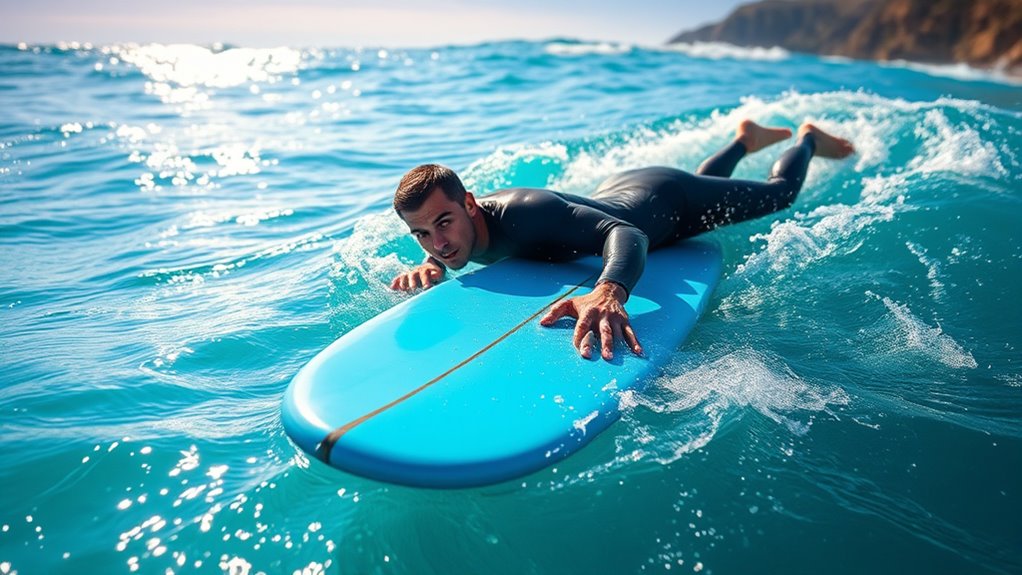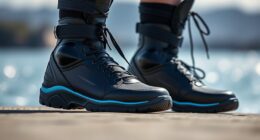To improve your paddling techniques for surfing, focus on maintaining proper body position by keeping your center over the board and your head up. Use long, steady strokes with your arms, engaging your core and legs for power. Keep your grip relaxed and paddle on a straight line, adjusting your effort to match wave speed. Good wave timing and proper technique help catch waves efficiently. Continue exploring these tips to boost your paddling skills even further.
Key Takeaways
- Maintain proper hand placement shoulder-width apart with a relaxed grip for maximum power and efficiency.
- Keep your body centered, with chest slightly forward and hips aligned, to improve balance and streamline movement.
- Use long, steady, and powerful arm strokes, engaging core muscles and keeping elbows close to the body.
- Incorporate controlled kicks with your legs to add propulsion and maintain stability during paddling.
- Focus on timing your wave takeoff early and paddling steadily to match the wave’s speed for a successful catch.
Choosing the Right Paddle and Equipment
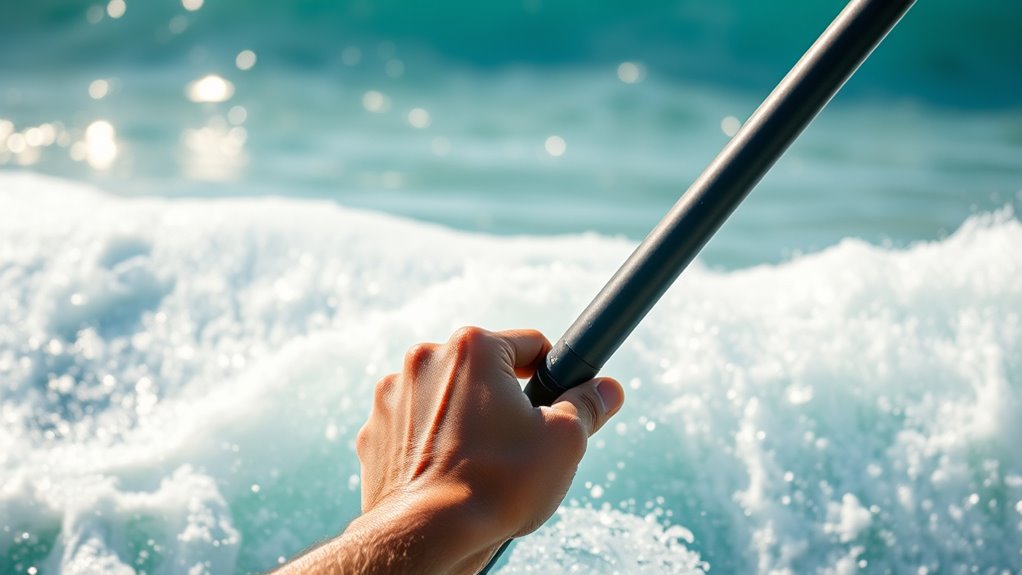
Selecting the right paddle and equipment is vital for efficient and comfortable surfing. Your paddle’s material profoundly impacts performance; lightweight options like fiberglass or carbon fiber reduce fatigue, while foam or plastic paddles are more durable and budget-friendly. When choosing, consider your skill level and typical surf conditions. Proper equipment maintenance is also essential—rinse your paddle after each session to prevent salt and sand buildup, and store it in a cool, dry place to avoid warping. Regularly inspect your paddle for cracks or damage, replacing it if necessary. Well-maintained gear not only extends its lifespan but also guarantees your paddling remains smooth and effective, helping you catch more waves with less effort and increasing your overall surfing enjoyment. Additionally, understanding the contrast ratio of your equipment can help optimize visibility and performance in different lighting conditions. Incorporating performance upgrades like specialized blades can further enhance your paddling efficiency, especially in challenging surf environments. Paying attention to drivetrain maintenance, such as inspecting your chain and gears, can also improve your overall paddling experience by ensuring smooth and reliable operation. Being aware of ergonomic design features in paddles can also reduce fatigue and improve comfort during long sessions.
Perfecting Your Body Position on the Board
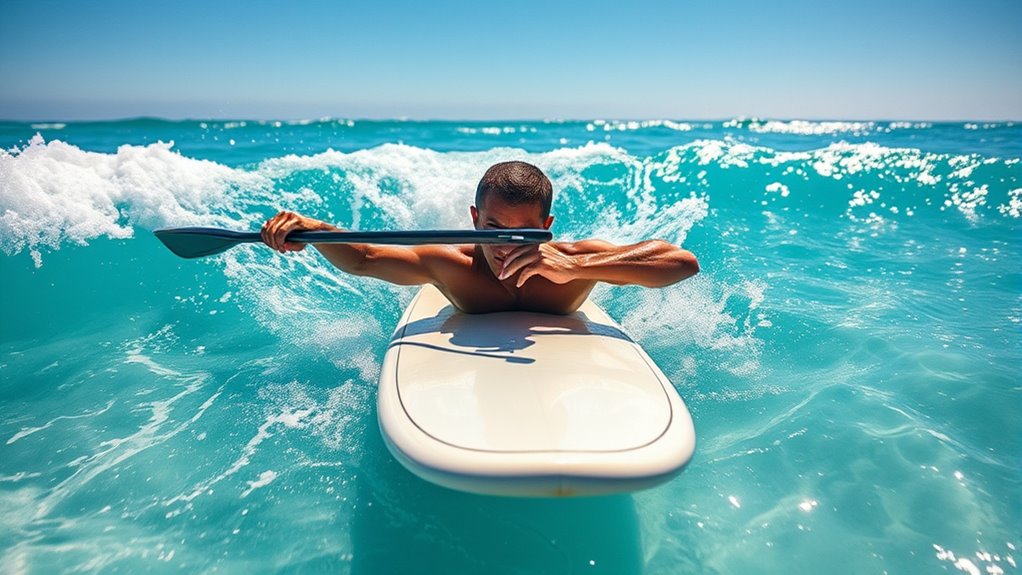
To improve your paddling, focus on maintaining your center of gravity over the board to stay balanced and efficient. Keep your head up and eyes forward to help with alignment and navigation. Proper positioning makes paddling easier and prepares you for catching waves.
Center of Gravity Balance
Maintaining a centered and low center of gravity is essential for stable and controlled surfing. Your center of gravity affects your balance, making it easier to stay on the board, especially in choppy water. To improve your balance, focus on proper weight distribution—keeping your weight evenly spread across the board. Shift your hips slightly forward or back as needed to stay aligned with the wave and avoid tipping. Keep your knees slightly bent and stay relaxed to adapt quickly to changing conditions. By consciously controlling your center of gravity, you’ll enhance stability during paddling and when catching waves. Regular practice of body awareness can significantly improve your ability to adjust your position instinctively. Developing dynamic communication exercises can also help you stay more aware of your movements and maintain better control on your board. Additionally, practicing center of gravity balance can help you respond more effectively to varying surf situations. Incorporating posture alignment techniques can further optimize your stability and control in different surf environments, and understanding body mechanics can lead to more efficient movement and injury prevention.
Head and Eye Alignment
Proper head and eye alignment play a vital role in your overall body position on the surfboard. Keeping your eye focus steady on the horizon or the wave’s peak helps maintain balance and direction. Avoid looking down at your feet or the board, as this can cause unnecessary head tilt and destabilize your posture. Instead, keep your head upright or slightly tilted forward, aligning it with your spine for better control. Your eye focus should be forward, not downward, to anticipate wave movements and respond quickly. Proper head and eye alignment improve your paddling efficiency and help you stay centered on the board. Mastering this aspect of body positioning allows for smoother paddling and better wave selection.
Mastering the Basic Forward Stroke
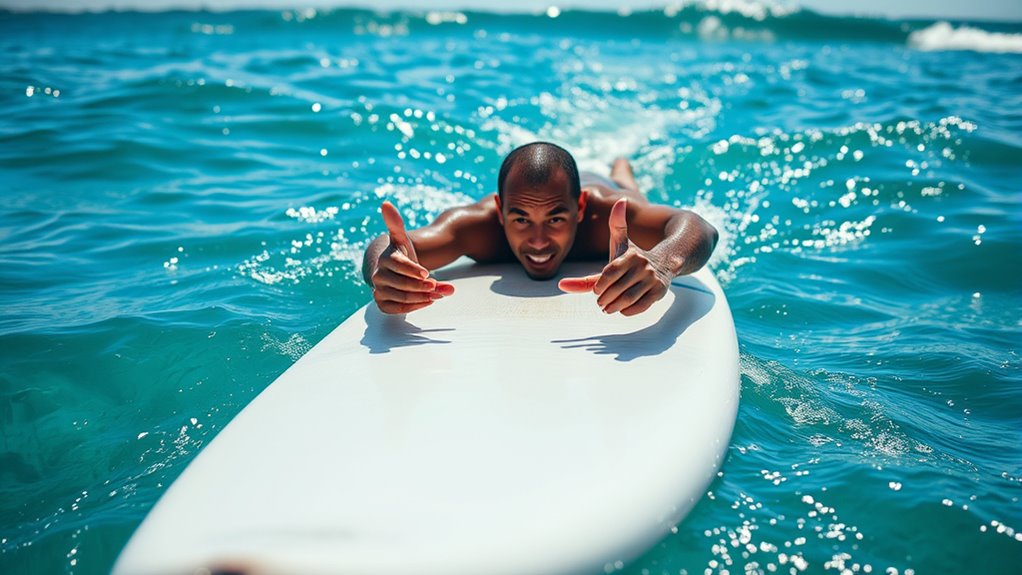
To master the basic forward stroke, focus on proper hand placement to maximize your power and efficiency. Keep your body aligned and use your core to drive your movements, not just your arms. When you get these points right, paddling becomes smoother and more effective.
Proper Hand Placement
Mastering proper hand placement is essential for executing an effective basic forward stroke while surfing. Your hand placement affects your paddle grip, which directly influences your power and control. To optimize your technique:
- Keep your hands shoulder-width apart on the paddle shaft, ensuring a comfortable paddle grip that allows for smooth, efficient strokes.
- Maintain a relaxed grip to avoid fatigue and improve maneuverability.
- As you paddle, keep your hands aligned with your body, driving through the water with a steady, controlled motion.
- Incorporating proper hand positioning enhances your overall paddling efficiency and prevents strain or injury. Being aware of technique improvements can further refine your strokes for better performance.
- Paying attention to body alignment can help maximize your paddling power and reduce unnecessary energy expenditure. Proper body posture also supports sustained paddling over longer periods.
- Consistently practicing correct hand placement and paddle technique can lead to significant improvements in your surfing endurance and wave-catching success.
Focusing on correct hand placement helps you generate more propulsion with less effort. Remember, a proper paddle grip and hand position are the foundation for effective paddling, helping you catch waves more easily and surf longer.
Effective Body Position
Having the right body position is essential for executing an efficient basic forward stroke while surfing. Keep your body centered on the board, with your chest slightly forward and hips aligned. Maintain a streamlined posture to reduce drag and conserve energy. Focus on breath control to stay relaxed, which helps you paddle smoothly and sustain your effort. Your paddle rhythm should be steady and consistent, with long, powerful strokes that maximize propulsion. Keep your elbows close to your body and extend your arms fully during each stroke. Avoid unnecessary movements that can disrupt your balance or waste energy. Proper technique also involves understanding paddling efficiency, which is key to conserving stamina and catching waves more effectively. Additionally, aligning your body correctly can improve your overall asset division of energy, making your paddling more effective and less tiring. Developing good pacing and timing also plays a vital role in maximizing your energy output, ensuring you can paddle longer and more comfortably. Focusing on proper body positioning helps maintain a smooth rhythm and reduces fatigue during extended paddling sessions. Incorporating inflation protection strategies can help you stay comfortable in variable surf conditions, conserving energy for when you need it most. By practicing this body position, you’ll improve your paddling efficiency, making it easier to catch waves and conserve stamina for longer sessions.
Using Your Arms and Legs Effectively
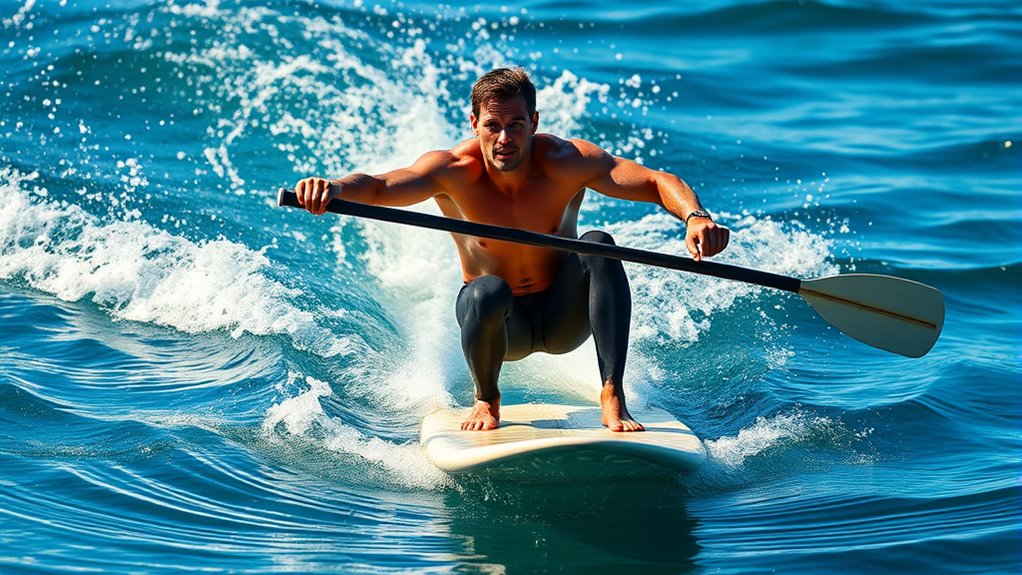
Efficiently using your arms and legs is essential for maintaining balance and generating power on your surfboard. Strong arm movements help you paddle smoothly, conserving energy and improving arm strength over time. Your legs provide fundamental propulsion; by kicking consistently, you add leg propulsion, helping you move forward more efficiently. To maximize effectiveness:
- Focus on arm strength by using long, powerful strokes rather than quick, shallow pulls.
- Engage your legs with steady, controlled kicks that supplement arm movements.
- Keep your body aligned, using your core to transfer power from your arms and legs smoothly.
- Understanding proper paddling techniques can significantly enhance your efficiency and reduce fatigue during your surf sessions, especially when combined with body positioning for better control. Additionally, being aware of playground hours and planning your session during optimal times can help you avoid crowded conditions and improve your overall experience. Incorporating training methods used by professional surfers can also accelerate your progress and boost your stamina during longer surf sessions. Developing a consistent training routine can further improve your overall paddling efficiency and endurance.
Improving Your Breathing and Endurance
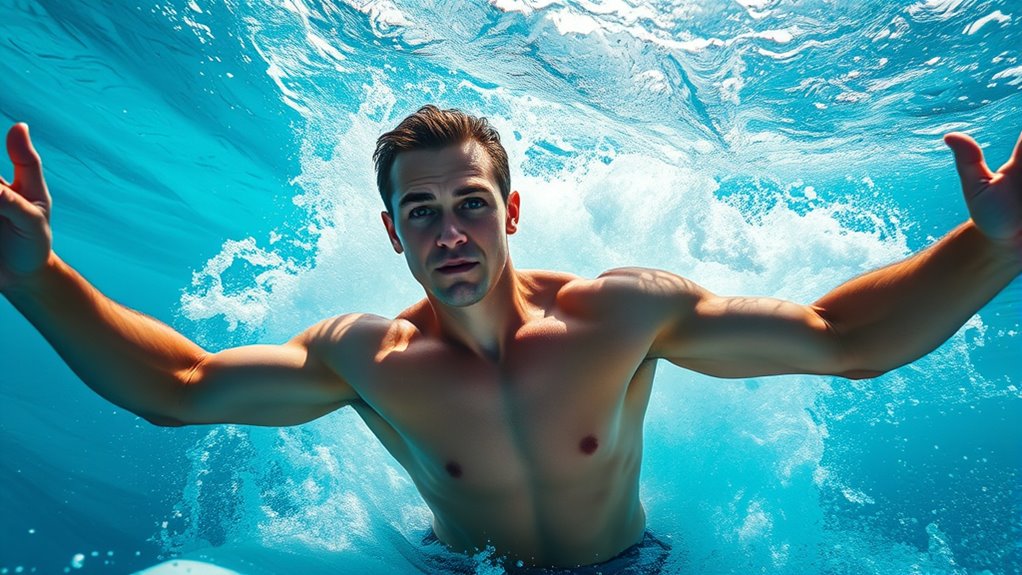
To improve your breathing and endurance on the water, focus on controlled, rhythmic breathing patterns that match your paddling pace. Practicing breathing control helps you stay relaxed and conserve energy during long sessions. Incorporate endurance training by gradually increasing your paddling time and intensity. Visualize your effort with this imagery:
| Calm Lake | Steady Paddling | Rising Sun |
|---|---|---|
| Deep breaths | Smooth strokes | Warm glow |
| Relaxed mind | Consistent rhythm | Endurance gain |
| Focused inhale/exhale | Steady pace | Confidence grows |
| Peaceful surroundings | Effortless flow | Strength builds |
| Breathing control | Resilient body | Surfing future |
Techniques for Catching Waves Efficiently
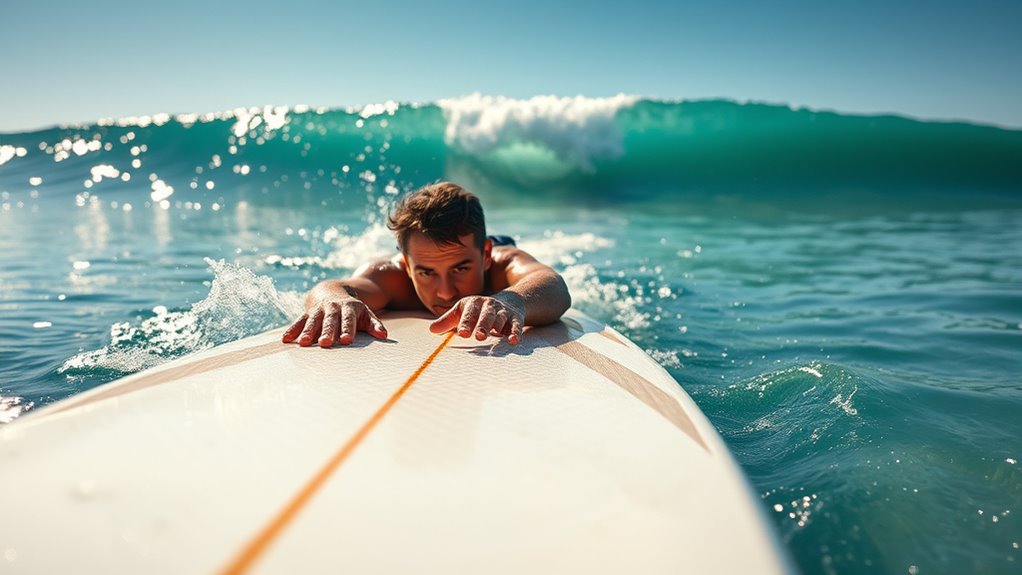
Catching waves smoothly begins with proper positioning and timing. To maximize your chances, focus on good wave selection by identifying the peak and approaching at the right moment. Paddling etiquette is vital—always give way to the surfer closest to the wave’s breaking point and avoid dropping in on others. Here are three tips to catch waves efficiently:
- Choose the right wave – Look for a wave that’s clean and peeling, not too crowded.
- Position yourself correctly – Lie flat and centered on your board, paddling hard to match the wave’s speed.
- Time your takeoff – Start paddling early, maintaining steady effort until you feel the wave lift your board.
Mastering wave selection and paddling etiquette helps you catch waves more successfully and respectfully.
Managing Your Speed and Power
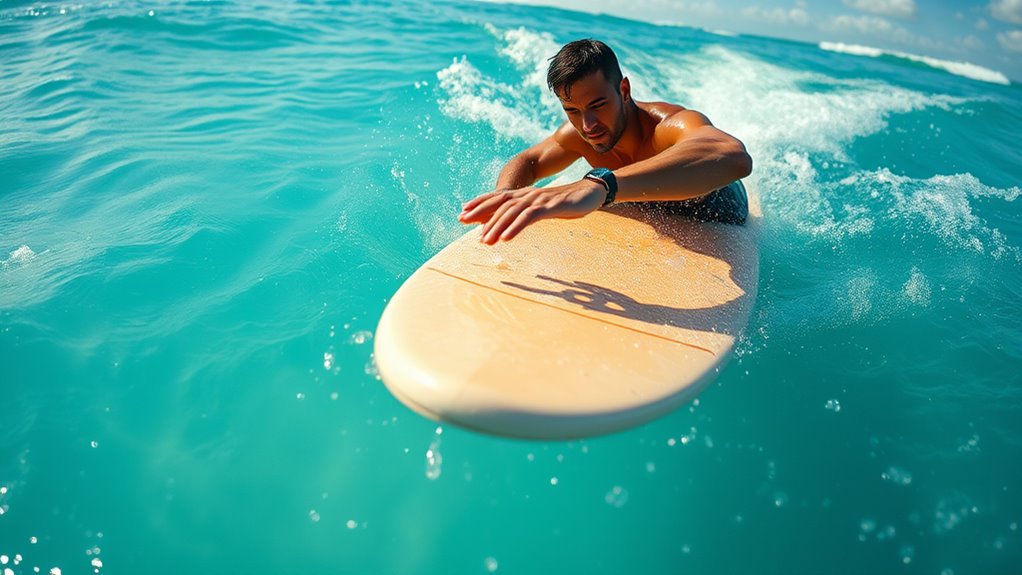
Managing your speed and power is essential for maintaining control and making the most of each wave. To do this, pay attention to the wave speed and adjust your paddle rhythm accordingly. When a wave approaches faster, increase your paddling pace to stay ahead of it, but avoid overexerting yourself. Conversely, if the wave slows down, slow your paddle rhythm to conserve energy and prevent losing momentum. Consistency is key—maintaining a steady paddle rhythm helps you regulate your speed smoothly. Focus on small, controlled strokes rather than large, erratic ones, allowing you to respond to changing wave conditions effectively. This balance between paddle effort and wave speed ensures you stay in sync with the wave, maximizing your control and readiness for the next move.
Turning and Maneuvering While Paddling
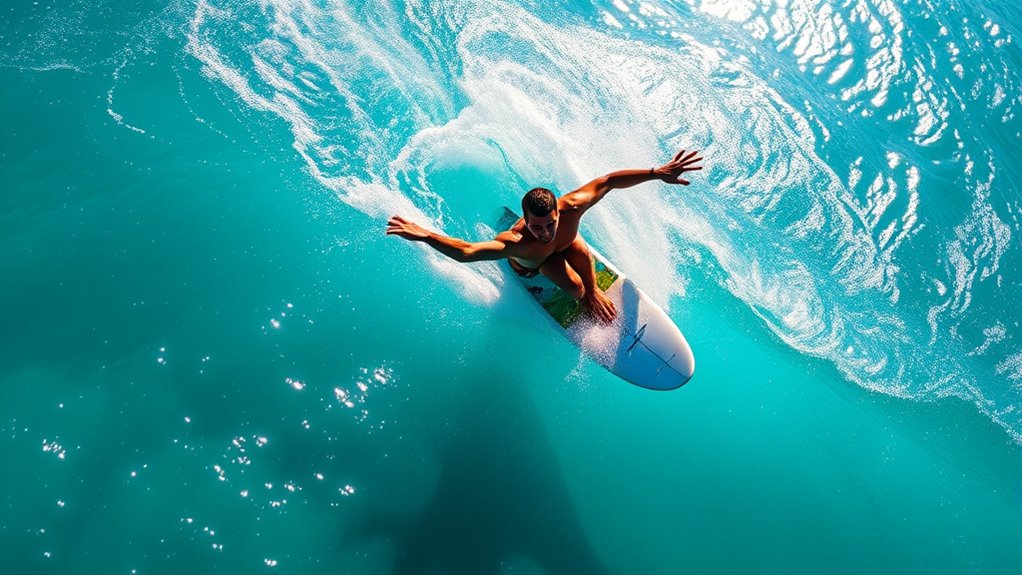
When you need to change direction on your surfboard, precise paddling and body positioning become your best tools. Understanding wave dynamics helps you anticipate movement, so you can adjust your course smoothly. To turn effectively while paddling:
- Use paddle grip techniques that give you control, positioning your hands correctly for quick responses.
- Shift your body weight by leaning slightly into the turn, keeping your hips and shoulders aligned.
- Apply targeted paddle strokes on one side to generate momentum and steer your board in the desired direction.
Mastering these techniques lets you maneuver with agility, making your paddling more efficient and responsive to changing wave conditions. Proper paddle grip and body positioning are essential for seamless turns and better control.
Tips for Paddling in Different Water Conditions
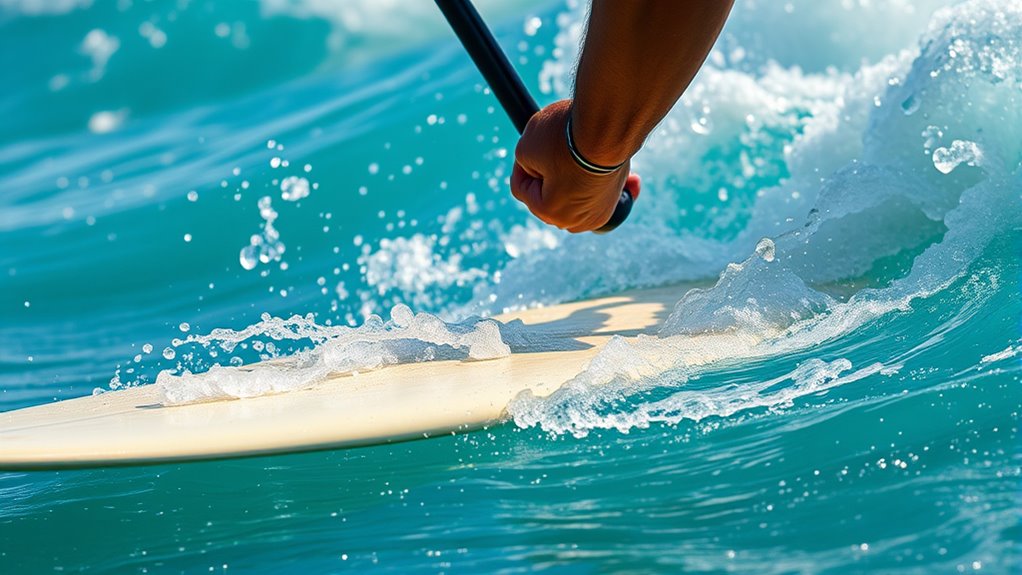
Paddling effectively in different water conditions requires adjusting your technique to match the environment. When wave reading, pay close attention to how waves form and break, so you can time your paddling accordingly. For choppy or rough waters, use longer, more deliberate strokes to stay balanced and maintain control. In tidal areas, tide awareness is vital; rising tides can make paddling easier by lifting your board, while low tides might expose obstacles or create stronger currents. Adapt your approach by shifting your weight and adjusting your paddling speed based on the water’s behavior. By understanding wave reading and tide patterns, you’ll conserve energy, stay safer, and improve your chances of catching the right wave in any water condition.
Frequently Asked Questions
How Can I Reduce Arm Fatigue During Long Paddling Sessions?
To reduce arm fatigue during long paddling sessions, focus on improving your paddle stroke efficiency. Use smooth, controlled movements rather than forceful ones, and make certain your arm muscles stay relaxed throughout. Rotate your torso and engage your core to share the workload, instead of relying solely on your arms. Taking regular breaks and stretching can also help prevent fatigue, making your paddling more comfortable and sustainable over time.
What Are Common Mistakes Beginners Make When Paddling?
Imagine your paddling journey as a smooth river, flowing effortlessly. Beginners often make mistakes like improper hand placement, which acts like a tangled rope slowing you down, or neglecting breathing techniques, leaving you breathless in rough waters. To improve, focus on proper hand placement to glide smoothly and breathe deeply to conserve energy. These small adjustments will turn your paddling into a confident cruise, not a tiring struggle.
How Do I Stay Balanced While Paddling in Choppy Water?
To stay balanced while paddling in choppy water, focus on wave timing and paddle positioning. Keep your weight centered on your board, engaging your core for stability. As you paddle, anticipate wave movements and adjust your paddle strokes smoothly to maintain control. Look ahead, not down, to better gauge the water’s rhythm. This helps you stay balanced, reduces fatigue, and prepares you for catching waves more effectively.
What Are the Best Techniques for Paddling in Crowded Surf Zones?
In crowded surf zones, you want to focus on wave timing and maintaining a steady paddle rhythm. Watch for incoming waves and time your paddles to match their approach, avoiding collisions. Keep your movements smooth and consistent, staying alert to surfers around you. This helps you stay in control, conserve energy, and avoid accidents while ensuring you’re ready to catch the next wave when it arrives.
How Can I Improve My Paddling Efficiency Over Time?
Imagine you’re a modern-day explorer, and your goal is to improve your paddling efficiency over time. Focus on refining your proper stroke, maintaining smooth, powerful pulls, and engaging your core muscles. Regularly evaluate your equipment selection—using a board suited to your skill level and conditions can make a big difference. Practice consistently, and over time, you’ll notice less fatigue and more effective paddling, just like a seasoned adventurer.
Conclusion
Mastering these paddling techniques will turn you into an unstoppable wave-catching machine. With perfect timing and unstoppable endurance, you’ll ride waves like a surfing legend, leaving others in your spray. Just imagine slicing through water with the speed of a rocket, conquering every swell with effortless grace. Keep practicing, stay persistent, and soon you’ll be the surfer everyone’s in awe of—so powerful, so swift, you’ll make the ocean bow to your skills!

